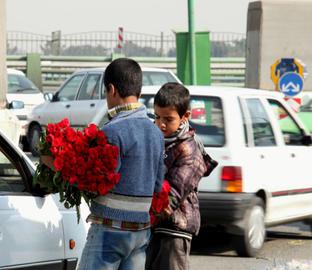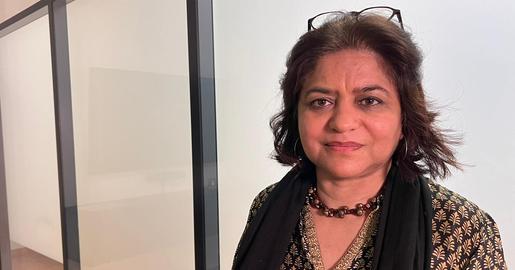In every country in the world, slavery is illegal. And yet it continues to thrive — and Iran has one of the highest numbers of victims.
Modern slavery includes forced labor, child labor, forced marriage, and human trafficking. Iranians, and particularly Iranian women and children, are vulnerable to these dangers inside the country, especially among poor communities where opportunities for work and education are scarce. Iranians who decide to leave the country for whatever reason — because of economic hardship or persecution — are also at risk of human trafficking and other slavery crimes.
“Slavery never ended,” says Terry FitzPatrick, the Communications and Advocacy Director at Free the Slaves, an international non-governmental organization and a lobby group that works to eradicate slavery around the world. “It was never abolished; it was actually outlawed. It was never really eradicated. So Free the Slaves exists to help finish the job that was started by earlier generations more than a century ago.”
Although the Iranian government does not provide reliable data on the extent of the problem, there is evidence that the main victims of trafficking in Iran are women. And a recent State Department Annual Trafficking in Persons Report designated Iran as a Tier 3 country, the lowest ranking possible, warning that “worsening economic and environmental conditions have significantly exacerbated Iran’s human trafficking problem, particularly for vulnerable communities such as ethnic minority groups, refugee and migrant populations, and women and children.”
Given the pervasiveness of slavery and human trafficking in Iran and around the world, it is important to understand the global scope of the problem and how international organizations against slavery have been fighting against it. Free the Slaves is one of them. Founded in 2000, the organization has developed a blueprint for change to inform governments, international institutions, faith communities, businesses and the public about what they can do to end slavery.
The organization has achieved impressive results since its foundation: it has helped free more than 14,000 people from slavery, and to educate and raise awareness among at least 650,000 people in trafficking hot spots. More than 300 traffickers have been arrested.
“It may have seemed impossible 150 years ago that the global slave trade could be ended because it was considered to be economically necessary," FitzPatrick says. "Some people even gave it a moral cover, so it was considered morally acceptable. And to have overcome those cultural, societal, and economic barriers to get it outlawed was a herculean task. But not everyone has enjoyed the benefits of those accomplishments. Modern forms of slavery have made a comeback all over the world today. That is how Free the Slaves came to be.”
Although he says there has been a "real global awakening” — in recent years, progressive laws have been adopted in many parts of the world — slavery is still prevalent and ruining lives, a reality Free the Slaves and many other organizations and campaigners confront daily. The idea that slavery is a thing of the past is a fallacy, as these groups’ work and research so clearly reveal. In fact, slavery has made a resurgence in recent years.
The Resurgence of Slavery
The United Nations International Labor Organization, working in partnership with the International Organization for Migration and the group Minderoo Walk Free in Australia, have estimated that there are currently 40 million people in slavery, 21 million of them in forced labor —“at farms, plantations, in factories, in mines, on fishing boats, as domestic servants in private homes,” FitzPatrick says, adding that “25% of them are children...who are forced to work in conditions of human trafficking — there are 4 million of them.
“Around 4 million are in what we could call sex slavery,” he says. “Fifteen million are in more newly-recognized slavery, which is forced marriage. This isn’t just arranged marriage — it’s children being sold off to pay debts in marriage and not just for work.”
So, although it never went away, why has slavery had such a resurgence? “Because of globalization, a lot of work has moved from countries with strong labor standards that are well-enforced to countries with weaker labor standards that are not well-enforced,” FitzPatrick says. “With the globalization of trade, a lot of components and raw materials are moving around the world and are coming from places where slavery is easier to get away with.”
Another factor is demographic growth. “In many places, the population has grown faster than the economy,” says FitzPatrick. “So people must move away from home to work and send remittances back to the family.” Millions of people live and work in this way, but FitzPatrick says, “the recruitment of overseas and foreign labor is a largely unregulated industry. So traffickers can pose as legitimate labor recruiters. Once they get you away from your community, your family, your money, your documents, your language, your legal system, your cell phone — then they have got you.”
Then there’s corruption, he says, which “is tied in with weak enforcement of labor laws. You do not run a brothel anywhere in the world without some level of police corruption. The same is also true for forced labor crews working in plantations or factories. In many cases, it is not that the police do not know. In many cases, police are being paid not to look.”
People facing debt are also very much at risk, FitzPatrick says. “It makes people vulnerable. If people do not have adequate healthcare, if they do not have adequate access to banking services or credit, when a disaster strikes like a road accident or a climate-induced typhoon, a drought, or their house burns down, people have to borrow money immediately. If they cannot get free healthcare to pay a doctor or if they cannot go to a bank or find legitimate sources of credit, then they have to borrow from a mine-owner, a factory owner, or a money-broker. Then, they pledge to work off the debt under conditions of slavery.”
With slavery’s comeback, its image has changed: “The old image of slavery and the slave trade was primarily of Africans who were kidnapped by slave hunters who would then ship them to the Americas across the Atlantic or into Middle Eastern countries,” FitzPatrick says. “Today, you might think of the jumbo jet as the new slave ship. People arrive voluntarily. That is not my quote. That is a quote by one of the scholars who wrote the book The Slaves Next Door.”
Creating Awareness, Collecting Evidence, Talking to Governments, Involving People
With the launch of the organization, Free the Slaves focused its work around four key pillars, FitzPatrick says:
“1- Wake up the world to the fact that slavery has made a global comeback, in new forms, in new places, in new waves. It is widespread and it is not a little problem.
2- To do and foster academic quality research about the nature of the problem, its drivers, causes, what could be done about it, what’s effective and what isn’t. Those ideas were meant to create a body of knowledge so that people could agree on what can be and should be done as opposed to just charities saying, ‘here’s the number. Just give us money.’ There will be academic evidence of what the problem and solutions are.
3- We want to galvanize a governmental response. Non-profits cannot put people in jail. Only government can.
4- Experiment with people power: How on the frontlines in neighborhoods and in villages, we might educate and mobilize people to protect themselves, to liberate themselves, and to make sure that they’re not vulnerable so that once someone is liberated, they don’t fall back into slavery later in life or nobody else takes their place.”
Working with the international media, Free the Slaves has worked to raise awareness about modern-day slavery, and reached more than 500 million people around the world. “Raising awareness does not free anybody, but you cannot free anybody without raising awareness,” FitzPatrick says.
Governments, however, can make a difference. “Getting governments to get involved has been a major accomplishment,” he says, and harnessing academic expertise has been crucial too. “You can now get a master’s degree in human trafficking from several prestigious universities around the world. The first generation of us in the modern anti-slavery movement were just making it up as we went along. We are human rights activists, journalists, or filmmakers; we were not trained in sociology or international development. But now, there’s a body of evidence on how to do it.”
Finally, of course, it’s about setting people free. Free the Slaves estimates that it has liberated about 14,000 people since its inception. “Last year, we helped educate and train 650,000 people overseas on how to protect themselves, their families, and their communities from traffickers and slaveholders. We have helped put more than 300 traffickers behind bars while training hundreds and hundreds of government officials around the world about how to track down traffickers.”
Related coverage:
Girls Without A Future: The Rise of Forced Marriage in Iran
Trafficked Children on the Streets of Iran: Ignored by the Government, Unknown to People



























comments